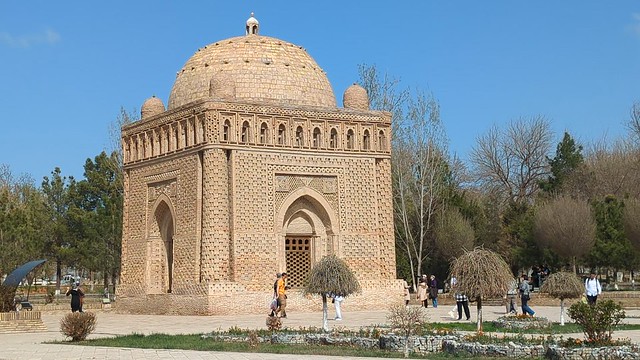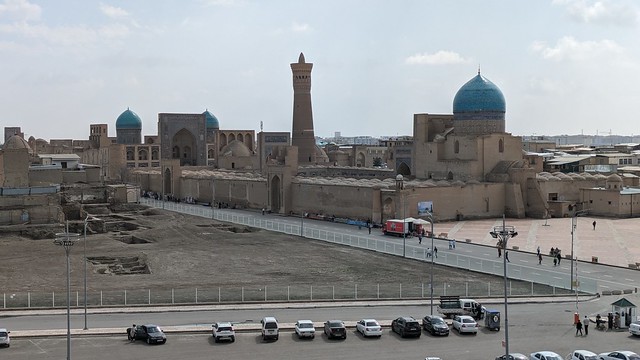- The early 10th century Samanid Mausoleum is the oldest example of brick on brick decoration that we are getting exposed to in Central Asia, as we are yet to visit Iran. See the short video below.

- We also got introduced to the kosh layout which consists of two large buildings - a mosque/madrasa or madrasa/madrasa — which face each other across a street or square, and are now wondering whether this is the reason we noticed so many twin towers in Dubai. Below is a mosque/madrasa combo, with the Kalon Mosque on the right and the Mir-i-Arab Madrasa on the left.

- The non-geometric decoration on the Nadir Divan Beghi Madrasa is a riot. The Madrasa was originally built as a caravanserai. Its splendor caught the khan's eye, therefore it was appropriated as a madrasa. Apparently it is more important to have a madrasa, even a sacrilegious madrasa.

On the 8-hour train ride Khiva to Bukhara, with older sleeper cars, and an ancient samovar. The final destination is Tashkent, and our compartment companions are settling in for the long trip. The fruit and nut trees are blooming outside adding some color to an otherwise bleak landscape. At one point we spotted a small herd of camels (6th below).






The Ark of Bukhara is a massive fortress made of earthen walls. First below is the iconic main gate. There are great views from atop the walls to the Old Town (2nd and 3rd below). The walls are being rebuilt using the old material and methods (4th below).




The Bolo Haouz Mosque is directly opposite the Ark. Its large, colorful, wooden iwan was very impressive. We were there just as noon prayers concluded and able to step inside the more modern prayer hall for a few minutes.



Bukhara is more than monumental buildings such as the Ark and the Kalan Complex. There are small, cozy, neighborhood mosques as well. Architecturally they follow the same plan as the large mosques - wooden iwan outside; and carpets, chandeliers, and fantastic ceilings inside - on a smaller scale.



The Kalan Complex was amazing. A 46-meter minaret, a mosque with a large courtyard, and colorful decoration.






Across the square is the active Mir-i-Arab Madrasa with over 100 male students. Visitors are not allowed, but one can look through a grill to the inner courtyard.


All that remains of the Chor Minor Madrasah is the gate.

One morning we are out walking in Bukhara near the Lyabi-Hauz Pond (2nd and 3rd below) and a guy asks me to help him set up his restuarant tables (1st below). OK?!



Veg dumplings from our "goto" Bukhara resto.


1 comment:
I particularly liked the entrance with the colbolt blue inlay. That was interesting to see the sleeper cars. Liz
Post a Comment